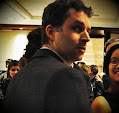The first capability we will look at is intentcasting.
What is intentcasting?
Interest brings groups together, but intent is what brings teams together to actually get things done.
Intentcasting is deceptively simple to describe. It consists in broadcasting your intent to make something happen. That something could be anything:
- "I want to have a party at my house!"
- "We want to raise $1,000 for Japan!"
- "I want this piece of software to exist!"
- "We want this work of art to exist!"
There is a capability that is the essential complement to intentcasting: intentcatching. Intentcatching means connecting to an intent that has already been cast, in effect signaling, "I want this to happen too" or "We want this to happen too" and moving from a passive to an active stance towards the intent.
At its core, intentcasting is invitation into a possible future. It is a statement of possibility, and will. Although the intentcast does not have to spell out how the intent is to materialize, it does contain the germ of an architecture of participation.
In order for intent to catch on, it has to meet a few conditions:
- It must describe a promise - a future state of affairs that could conceivably happen, explained in a way that people understand.
- It must open participation in one or more well-defined ways.
- It must be expressed in a way that enables it to travel and spread over the communications infrastructure.
- There must be other people or groups out there who resonate with the intent and can get excited enough to connect.
Once enough people have caught the intent, so that it has become shared intent, things can get moving pretty swiftly.
The state of the art of intentcasting
The social web offers a vast, quickly evolving landscape of new possibilities for intentcasting. Social tools that directly support intentcasting can be classified according to the modalities of participation that are offered to intent catchers (as we'll call those who respond to the intent):
- Crowdfunding services, where catchers are invited to support the intent by donating money. Kickstarter is probably the most famous crowdfunding website right now.
- Event platforms, where catchers are invited to announce their intent to attend the event. Plancast and Facebook Events fall in this category.
- Challenge markets / prize systems, where catchers is invited to submit a solution of their own to a challenge. ChallengePost is an example of a challenge market.
- Action platforms, where catchers is invited to support the intent by joining the effort and a collaboration framework is offered. IfWeRanTheWorld, Superfluid, andepic.io fall in this category.
- Goal-centered platforms, where the focus is squarely on the intent and catchers are simply invited to show support. A grandfather example of this is 43things. Facebook pages like this one do a similar job.
- Task managers / Project trackers, where intent is usually expressed as a task or issue that needs to be taken care of. Pivotal Tracker is an example of this.
Related features
Tools that support intentcasting typically:
- Provide a description of the intent.
- Identify the intent's originator.
- Provide a call to action - a way of overtly catching the intent.
- Identify the intent's catchers, and their form of involvement.
They may also:
- Point to related intents. For instance, some intents may be stepping stones to a more ambitious intent.
- Make the intent into a shareable social object.
- Express the intent in a machine-readable form, following a standard.
The latter feature opens the way to Intent Maps.
The vision of the Intent Map
Imagine having access to a comprehensive map of intents, being able to navigate your way towards those intents that most speak to you and your skills and talents, and being offered an array of means of connecting meaningfully to them. That is the vision of the Intent Map.
The Intent Map could exist in a specific context (a group, an enterprise), but if you think about it for a minute, I believe you will agree that a global map of all intents that have been made public would be seven shades of awesome.
One way this could happen is using the federation approach, if the various tools that support intentcasting agreed on a microformat to represent intent. A crawler/aggregator could index these intents, and a filtering and visualization tool could be built on top of that to let us navigate the map.
Such a tool could catalyze self-organization on a large scale and help everyone shorten the path between wish and realization.
Acknowledgement: This blueprint was inspired by conversations with Fred Mir (who wrote "ideas for developing a semantic web for the people and by the people"), Vincent Chapdelaine, Mark Frazier, Jarno Koponen, Ishan Markandeya, Flemming Funch, George Por and Lion Kimbro.
Follow me on Twitter

